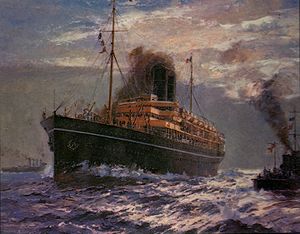RMS Medina (1911)
 | |
| History | |
|---|---|
| Name: | RMS Medina |
| Owner: | P&O Steam Navigation Co |
| Port of registry: | London |
| Route: | London – Australia mail route |
| Builder: | Caird & Company, Greenock, Scotland |
| Cost: | £332,377 |
| Yard number: | 317 |
| Launched: | 14 March 1911 |
| Completed: | 10 October 1911 (commissioned) |
| Maiden voyage: | 11 November 1911 |
| Identification: | Official No 131849 |
| Fate: | torpedoed off Start Point, Devon on 28 April 1917 by SM UB-31 |
| General characteristics | |
| Class and type: | P&O M-Class[1] |
| Tonnage: | 12,358 tons |
| Length: | 550 ft (170 m) |
| Beam: | 62 ft (19 m) |
| Depth: | 34 ft 4 in (10.46 m) |
| Installed power: | Coal fired quadruple-expansion steam engines rated at 1,400 ihp |
| Propulsion: | twin screw |
| Speed: | 19 knots (35 km/h) |
| Capacity: |
|
RMS Medina was an ocean liner built by Caird and Company, Greenock, Scotland, in 1911,[1] for the Peninsular and Oriental Steam Navigation Company. She was a Royal Mail Ship intended for use on the London to Australia route[1] and was the last of the ten ships in P&O's M-Class.[1]
 SS Medina, P&O ship in 1915 at Port Said, Egypt | Design and building The RMS Medina was the last of ten ships[2] ordered by the Peninsular and Oriental Steam Navigation Company of the ‘M’ class.[2] The order was placed with Caird and Company of Greenock, Scotland. She was 550 feet long and 62 feet wide with a depth of 34 feet. She was to carry 670 passengers, 450 in first class and 220 in second.[1] She was powered by quadruple-expansion steam engines which produced 1,400 horse power two her twin screws which moved through the water at a top speed of 19 knots (35 km/h).[1] During building it was decided that Medina would take King George V and Queen Mary to India for the Delhi Durbar. Medina was, therefore, initially commissioned into the Royal Navy as the Royal Yacht and her crew were mainly naval personnel. Medina was provided with an extra mast, necessary to maintain Royal flag etiquette and furnished with a white hull with bands of royal blue and gold and buff funnels. Various large rooms intended for public use were redecorated as Royal apartments. |
Contents
1 Maiden Voyage
2 Torpedoed
3 References
4 External links
Maiden Voyage
Medina left Portsmouth for India in November 1911, returning in February 1912 where she returned to Caird and Co. for refitting. She was then delivered to P&O in June 1912. She had only two years of peacetime service before the First World War broke out, but remained with P&O during the war.
Torpedoed
SM UB-31 torpedoed her off Start Point, Devon on 28 April 1917.[3]
Today Medina's wreck is upright with a 15 degree list to port. She is reasonably intact despite salvage of copper and passengers' baggage from forward holds. Her stern is most damaged and she is sinking into the mud of the seabed. Her bulkheads are collapsing and her compartments are folding down.
References
^ abcdef Padfield, Peter (1981). Beneath the House Flag of the P&O. London: Hutchinson. p. not cited. ISBN 0-09-145760-2..mw-parser-output cite.citation{font-style:inherit}.mw-parser-output .citation q{quotes:"""""""'""'"}.mw-parser-output .citation .cs1-lock-free a{background:url("//upload.wikimedia.org/wikipedia/commons/thumb/6/65/Lock-green.svg/9px-Lock-green.svg.png")no-repeat;background-position:right .1em center}.mw-parser-output .citation .cs1-lock-limited a,.mw-parser-output .citation .cs1-lock-registration a{background:url("//upload.wikimedia.org/wikipedia/commons/thumb/d/d6/Lock-gray-alt-2.svg/9px-Lock-gray-alt-2.svg.png")no-repeat;background-position:right .1em center}.mw-parser-output .citation .cs1-lock-subscription a{background:url("//upload.wikimedia.org/wikipedia/commons/thumb/a/aa/Lock-red-alt-2.svg/9px-Lock-red-alt-2.svg.png")no-repeat;background-position:right .1em center}.mw-parser-output .cs1-subscription,.mw-parser-output .cs1-registration{color:#555}.mw-parser-output .cs1-subscription span,.mw-parser-output .cs1-registration span{border-bottom:1px dotted;cursor:help}.mw-parser-output .cs1-ws-icon a{background:url("//upload.wikimedia.org/wikipedia/commons/thumb/4/4c/Wikisource-logo.svg/12px-Wikisource-logo.svg.png")no-repeat;background-position:right .1em center}.mw-parser-output code.cs1-code{color:inherit;background:inherit;border:inherit;padding:inherit}.mw-parser-output .cs1-hidden-error{display:none;font-size:100%}.mw-parser-output .cs1-visible-error{font-size:100%}.mw-parser-output .cs1-maint{display:none;color:#33aa33;margin-left:0.3em}.mw-parser-output .cs1-subscription,.mw-parser-output .cs1-registration,.mw-parser-output .cs1-format{font-size:95%}.mw-parser-output .cs1-kern-left,.mw-parser-output .cs1-kern-wl-left{padding-left:0.2em}.mw-parser-output .cs1-kern-right,.mw-parser-output .cs1-kern-wl-right{padding-right:0.2em}
^ ab Howarth, David; Howarth, Peter (1986). The Story of P&O. Weidenfeld and Nicolson. p. not cited. ISBN 0-297-78965-1.
^ Helgason, Guðmundur. "Ships hit during WWI: Medina". German and Austrian U-boats of World War I - Kaiserliche Marine - Uboat.net. Retrieved 2 November 2012.
External links
Lettens, Jan (3 April 2011). "SS Medina [+1917]". wrecksite.eu.
Coordinates: 50°15′00″N 3°30′00″W / 50.2500°N 3.5000°W / 50.2500; -3.5000